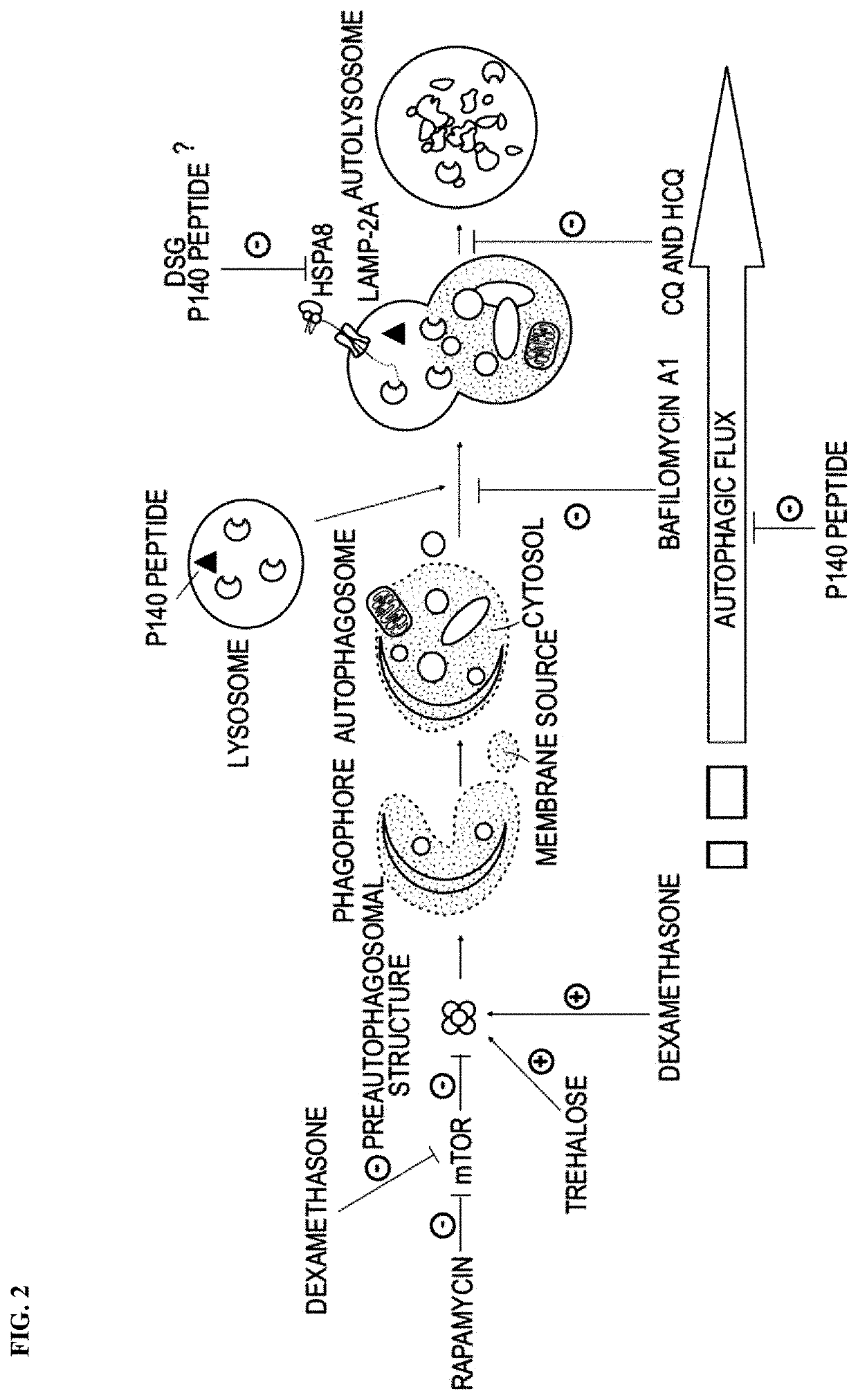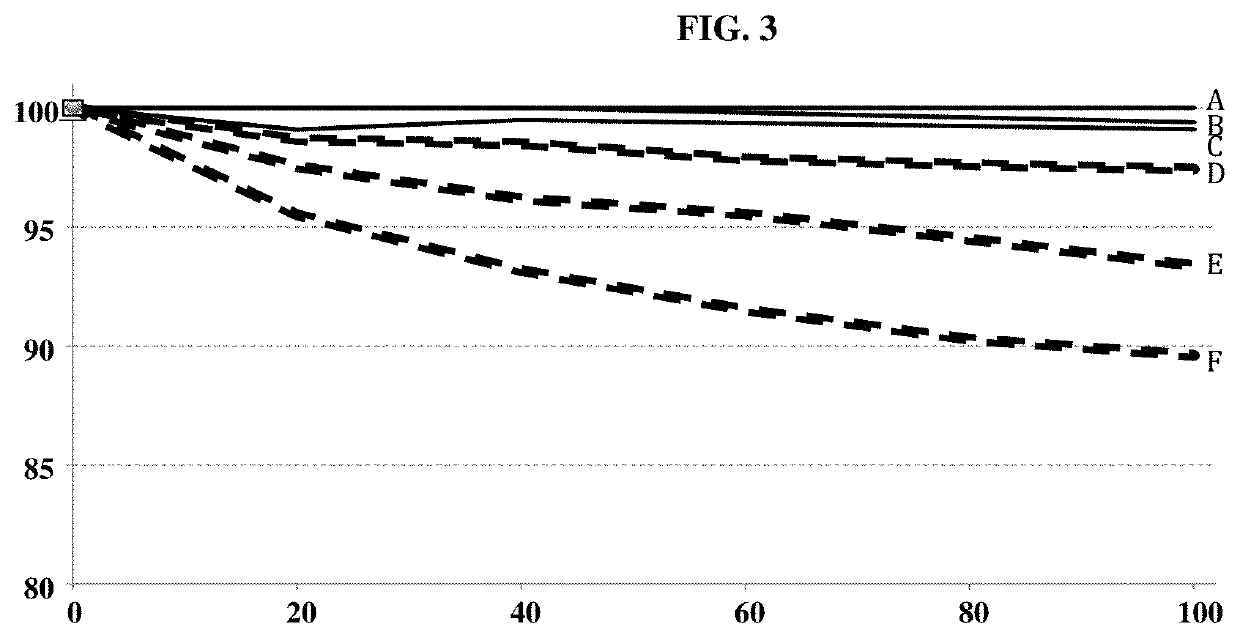Modified peptides and their use for treating systemic lupus erythematosus
a technology of lupus erythematosus and modified peptides, which is applied in the field of modified peptides and their use for treating systemic lupus erythematosus, can solve the problems of complex follow-up and treatment tasks, no known prevention for most autoimmune disorders, and no universal signature could be identified, so as to achieve the effect of increasing autophagy flux, increasing chaperone-mediated autophagy, and facilitating autophagy
- Summary
- Abstract
- Description
- Claims
- Application Information
AI Technical Summary
Benefits of technology
Problems solved by technology
Method used
Image
Examples
example 1
Synthesis of the Peptides
[0220]P140 peptide and P140(MO) were synthesized using classical Fmoc (N-[9-fluorenyl] methoxycarbonyl) solid-phase chemistry and purified by reversed-phase high-performance liquid chromatography (HPLC; Neimark and Briand, 1993; Monneaux et al., 2003, Eur. J. Immunol. 33, 287-296; Page et al., 2009, PloS ONE 4, e5273). Their homogeneity was checked by analytical HPLC, and their identity was assessed by LC / MS on a Finnigan LCQ Advantage Max system (Thermo Fischer Scientific). After completion of the reaction, the peptides were purified by HPLC.
[0221]In order to introduce the phosphorylation at the serine residue equivalent to the residue 140 of SEQ ID NO: 3, an Fmoc-Ser(PO(Obz)OH)—OH-type serine derivative was used. The coupling time is increased to 30 minutes and a second coupling is carried out systematically. After cleavage in acid medium, each peptide is precipitated by cold ether, solubilized in a solution of water and acetonitrile and finally lyophilize...
example 2
of the Peptides
[0222]The stability of the peptide SEQ ID NO: 1 in which the serine at position 10 is phosphorylated and the methionine at position 4 is oxydized (P140(MO)), and the peptide SEQ ID NO: 1 in which the serine at position 10 is phosphorylated (P140) was measured at 37° C., in a solution of 10% (v / v) mannitol. For each peptide, 3 concentrations have been tested: 200, 100 and 50 μg / mL.
[0223]At the indicated time, the integrity of P140 and P140(MO) peptides was measured in saline by high-performance liquid chromatography from the area of the peak corresponding to the intact peptide.
[0224]Results are shown in FIG. 3.
[0225]The following tables 1 and 2 summarize the results:
TABLE 1P140(MO) P140Days 200 μg / mL 100 μg / mL 50 μg / mL 200 μg / mL 100 μg / mL 50 μg / mLStability 0 100 100 100 100 100 100 (%) 20 100 99.1 100 98.7 97.5 95.5 40 100 99.5 100 98.5 96.2 93.2 60 ———97.9 95.5 91.5 80 ———97.6 94.5 90.3 100 100 99.1 99.4 97.4 93.4 89.6
TABLE 2P140(MO) P140 Days 200 μg / mL 100 μg / mL 50 μ...
example 3
ic Effect of the Peptides in MRL / Lpr Mice
[0230]MRL / lpr mouse strain is a mouse substrain that is genetically predisposed to the development of systemic lupus erythematosus-like syndrome, which has been found to be clinically similar to the human disease. It has been determined that this mouse strain carries a mutation in the fas gene. Also, the MRL / lpr is a useful model to study behavioural and cognitive deficits found in autoimmune diseases and the efficacy of immunosuppressive agents [Monneaux et al., 2003, Eur. J. Immunol. 33, 287-296].
[0231]2.1—Survival Analysis
[0232]Five-week-old female MRL / lpr mice received P140 or peptide P140(MO) intravenously as described (Monneaux et al., 2003, Eur. J. Immunol. 33, 287-296). All experimental protocols were carried out with the approval of the local Institutional Animal Care and Use Committee (CREMEAS). As control, mice were injected with NaCl.
[0233]Twenty mice were used for each peptide or NaCl.
[0234]The results are shown in FIG. 4.
[0235]A...
PUM
| Property | Measurement | Unit |
|---|---|---|
| surface plasmon resonance | aaaaa | aaaaa |
| size | aaaaa | aaaaa |
| blood pressure | aaaaa | aaaaa |
Abstract
Description
Claims
Application Information
 Login to view more
Login to view more - R&D Engineer
- R&D Manager
- IP Professional
- Industry Leading Data Capabilities
- Powerful AI technology
- Patent DNA Extraction
Browse by: Latest US Patents, China's latest patents, Technical Efficacy Thesaurus, Application Domain, Technology Topic.
© 2024 PatSnap. All rights reserved.Legal|Privacy policy|Modern Slavery Act Transparency Statement|Sitemap



